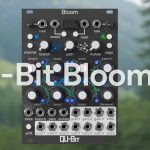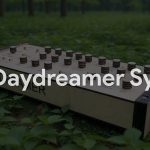The MD2 That Transforms Performance Into Programming
Most sequencer upgrades add more channels, more steps, or more effects while preserving the fundamental interface that made the original successful. But Noise Engineering’s Mimetic Digitwolis (affectionately known as MD2) takes a radically different approach—it rebuilds the legendary Cartesian performance sequencer from the ground up, transforming every aspect of the original while preserving its essential performative soul.
The Digitwolis doesn’t just improve upon the classic Mimetic Digitalis; it reimagines what a 10HP sequencer can be when every input becomes configurable, every output becomes flexible, and every parameter becomes a gateway to new creative territories.
From Digitalis to Digitwolis: Evolution Through Revolution
The original Mimetic Digitalis established itself as the king of Cartesian sequencing—a compact module that made complex X/Y navigation feel immediate and musical. But after years of user feedback and technological advancement, Noise Engineering faced a choice: incremental improvement or fundamental reimagining.
They chose revolution. The Digitwolis preserves the performative concepts that made the original beloved while unleashing entirely new ways to interact with Eurorack sequencing. It’s the same essential philosophy expressed through completely rethought hardware and software architecture.
Configurable Everything: The End of Fixed Function
Where the original Digitalis had dedicated inputs and outputs for specific functions, the Digitwolis makes everything configurable. Four CV inputs (A/B/C/D) and five trigger inputs (R/1/2/3/4) can be assigned to any function across all four channels, while each output lane can independently operate as modulation CV, pitch CV, triggers, gates, or external quantizers.
Core Architecture:
- Four output lanes with independent configuration
- Four mappable CV inputs (A/B/C/D)
- Five mappable trigger inputs (R/1/2/3/4)
- MIDI in/out on TRS Type A jacks
- 10HP footprint with completely rethought interface
- Power consumption: +12V: 80mA, -12V: 20mA
This configurable approach transforms the Digitwolis from a fixed-function sequencer into a platform that adapts to your patching philosophy rather than imposing its own limitations.
Five Output Personalities: Beyond Traditional Sequencing
Each lane can assume one of five distinct personalities, creating hybrid configurations impossible with traditional sequencers:
CV Lanes: Unquantized modulation sources with configurable voltage ranges, slew limiting, and external scaling/offsetting capabilities.
Note Lanes: Quantized pitch sequencing with customizable scales editable via MIDI keyboard or internal interface, plus automatic scale reflection when parameters change.
Gate Lanes: Time-dependent binary outputs perfect for envelope generators and other sustained control applications.
Trig Lanes: Precise 5ms triggers for drum modules and other event-triggered destinations.
Qtiz Lanes: External signal quantizers that can simultaneously function as CV-to-MIDI converters, bridging analog and digital domains.
The ability to mix these personalities across lanes creates sequencing configurations that would require multiple modules in traditional systems.
Advanced Navigation: Beyond Linear Sequencing
The Digitwolis preserves and expands the Cartesian navigation that made the original unique. Each lane supports multiple dimensional arrangements (16×1, 8×2, 5×3, 4×3, 4×4) with independent X and Y axis control, creating grid-based sequencing that feels both mathematical and musical.
But linear sequencing isn’t abandoned—16×1 mode provides traditional forward/backward navigation with up to 16 steps per lane, while clock dividers (1-16) create polyrhythmic relationships between lanes without external modules.
Shred Goes External: Randomization as Performance Tool
One of the original Digitalis’s most beloved features was Shred—the randomization function that could instantly transform static sequences into evolving compositions. The Digitwolis makes Shred externally triggerable, transforming randomization from editing tool into performance technique.
Combined with external triggering for Zero (minimum values), Shift (sequence rotation), and stepped CV recording, the Digitwolis becomes a platform for generative performance where human intention and algorithmic surprise collaborate in real-time.
MIDI Integration: Bidirectional Creative Flow
The Digitwolis treats MIDI as a creative medium rather than just a synchronization protocol. MIDI keyboards can edit scales in real-time, creating dynamic harmonic shifts during performance. Program Change messages recall any of 24 save slots, while the module can output MIDI notes and CCs that reflect its internal sequencing activity.
The bidirectional MIDI implementation means the Digitwolis can serve as both master and slave, sequencing external gear while being controlled by DAW software or hardware controllers. CV lanes map to MIDI CCs 4-19, allowing external fader banks to provide direct step editing.
Transport Flexibility: From Internal Clock to Complex Sync
The comprehensive transport system accommodates every synchronization scenario from standalone operation to complex studio integration:
Internal Clock: Self-contained operation with adjustable BPM for complete independence.
MIDI Sync: Full MIDI clock and transport following with Start/Stop message handling.
DIN Sync: Classic 24PPQN synchronization for vintage gear integration.
Gate/Trigger Transport: Sophisticated run/clock/reset configurations for modular ecosystem integration.
This transport flexibility means the Digitwolis adapts to your studio workflow rather than imposing synchronization constraints.
The Interface Revolution: Complexity Made Accessible
Despite dramatically expanded functionality, the Digitwolis interface prioritizes immediate access over menu diving. The dual-screen system (Overview and Focus) provides both macro and micro perspectives, while extensive button combinations enable advanced editing without losing performance flow.
The legendary combo moves return with expanded functionality—Load+Shred for instant randomization, Save+Edit for hill patterns, Copy+Edit for sequence offset—plus new combinations that leverage the expanded architecture.
Memory Management: 24 Slots of Complete Recall
The comprehensive save system stores complete sequencer states—all lane configurations, input mappings, transport settings, scales, and sequence data—across 24 slots organized in four banks. This isn’t just pattern storage; it’s complete patch recall that transforms the Digitwolis into multiple sequencers sharing the same hardware.
The autosave functionality ensures work is never lost, while SysEx dump capability provides backup and sharing options for complex configurations.
Development Challenges: 8000 Lines of Real-Time Code
Noise Engineering’s design notes reveal the ambitious scope of the Digitwolis project. The firmware expanded from the original’s 1,500 lines to over 8,000 lines—their most complex non-DSP code to date. The development challenges of implementing hard real-time performance (1ms latency tolerance) while managing screen rendering, flash memory operations, and complex state machines resulted in sophisticated software architecture that pushes the hardware to its absolute limits.
This technical complexity remains invisible during use, but enables the kind of sophisticated functionality that wouldn’t be possible with simpler approaches.
Value Proposition: Platform Sequencing in 10HP
The Digitwolis represents exceptional value for comprehensive sequencing capability. Compare the cost of separate quantizers, clock dividers, trigger processors, and MIDI interfaces required to replicate its functionality, and the integrated approach becomes compelling beyond space savings.
At its core, the Digitwolis transforms sequencing from predetermined patterns into dynamic performance, where the boundary between composition and improvisation dissolves into creative flow.
The Cartesian Performance Future
The Mimetic Digitwolis embodies Noise Engineering’s vision of where hardware sequencing is headed—toward platforms that adapt to creative intention rather than imposing technical limitations. By making every aspect configurable while preserving immediate performability, it bridges the gap between flexible software and tactile hardware.
Whether you’re building generative compositions, performing dynamic live sets, or integrating complex studio workflows, the Digitwolis provides a foundation that grows with creative ambition rather than constraining it.
Ready to sequence beyond the boundaries? The Mimetic Digitwolis proves that the most powerful sequencers are those that disappear behind the music they enable, transforming technical possibility into creative inevitability.
Preorder now for $385USD from Noise Engineering website
About Me
Hi, I’m Canoy Dang. I grew up in Granada and now living in Málaga, in the south of Spain. Sound has always played a central role in my life — from early home recordings to the deeper, ongoing exploration of the modular synth world. Modular, semi-modular, and desktop synthesizers have become my main tools for expression, experimentation, and sometimes, simply for getting lost in the process.






